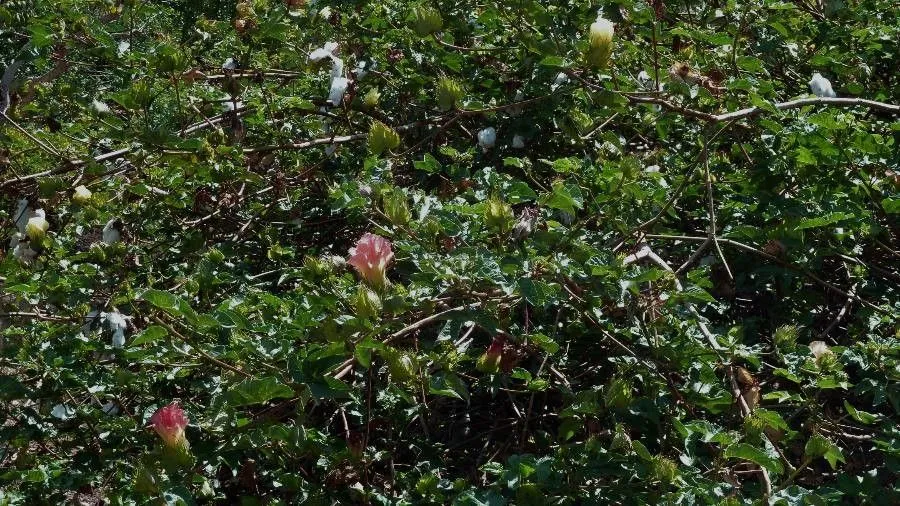
Author: L.
Bibliography: Sp. Pl.: 693 (1753)
Year: 1753
Status: accepted
Rank: species
Genus: Gossypium
Vegetable: False
Observations: India, Sri Lanka
Tree Cotton, known scientifically as Gossypium arboreum, is a cornerstone of traditional textile practices, with a rich history rooted in its native regions of India and Sri Lanka. This species belongs to the Malvaceae family, a group renowned for its economically and ecologically valuable members.
Gossypium arboreum stands out due to its hardy nature and the distinctive growth pattern that sets it apart from its herbaceous relatives. Unlike annual cotton plants, Tree Cotton is a perennial shrub, often reaching heights between 1 to 2 meters, though it can sometimes grow taller under favourable conditions. Its robust structure and larger size make it an impressive sight in both natural and cultivated landscapes.
The foliage of Tree Cotton is characterized by broad, lobed leaves that present a slightly rough texture. These leaves provide a lush green cover, contributing to the plant’s overall aesthetic appeal. The flowers are another striking feature, displaying a range of colors from creamy white to yellow or even pink, depending on the specific variety and environmental conditions. Blooms are typically large, funnel-shaped, and contribute significantly to the plant’s ornamental value.
However, the most notable aspect of Tree Cotton lies in its production of cotton fibers. The fibers are longer and coarser compared to those of the more widely known upland cotton (Gossypium hirsutum), offering distinct advantages for certain types of textile production. The historical and economic significance of Gossypium arboreum lies in its use for handspun yarns and threads, often sought after for their durability and unique texture. This ancient species played a crucial role in the early development of the textile industry in its native regions, where traditional handloom weavers utilized its fibers to create a variety of fabrics.
In terms of cultivation, Gossypium arboreum is well adapted to the climate of the Indian subcontinent, thriving in areas that experience both high temperatures and erratic rainfall. Its resilience against pests and diseases, which often plague other cotton species, makes it a preferred choice in sustainable agricultural practices. Additionally, its ability to grow on marginal lands with minimal inputs highlights its potential in promoting environmentally friendly farming.
Historically, Tree Cotton has been documented in botanical literature for centuries. Swedish botanist Carl Linnaeus, who is frequently referred to by the abbreviation “L.”, classified Gossypium arboreum in his seminal work “Species Plantarum” in 1753. This meticulous documentation helped in the scientific categorization and understanding of the plant, paving the way for future research and agricultural advancements.
Although modern cotton production has largely shifted to other species that offer higher yields and finer fibers, Gossypium arboreum remains valued in traditional practices and by niche markets that appreciate its unique qualities. The conservation and study of this species are crucial, not just for preserving genetic diversity within cotton species, but also for maintaining cultural heritage linked to age-old textile traditions.
In conclusion, Tree Cotton (Gossypium arboreum) is more than just a plant; it is a vital part of agricultural history and cultural identity in its native regions. Its sturdy growth, disease resistance, and distinct fiber qualities continue to make it relevant today, providing insights into sustainable farming and the preservation of traditional textile crafts.
Por: algodoeiro-arbóreo
Spa: algodonero arbóreo
Deu: baumformige baumwolle
Fra: coton arborescent
Eng: tree cotton
Swe: trädbomull
En: Tree cotton
Ar: قطن شجري
Ca: Cotoner arbori
Zh: Shu mian, 亚洲树棉
Da: Træagtig Bomuld
Fr: Coton arborescent, Cotonnier en arbre
De: Baumformige Baumwolle
Ja: Wata
Ko: Moghwa
Ne: कपासको बोट
Fa: پنبه درختی
Pt: Algodoeiro-arbóreo
Es: Algodonero arbóreo
Sv: Trädbomull
Uz: Hindixitoy gʻoʻzasi
© copyright of the Board of Trustees of the Royal Botanic Gardens, Kew.
© copyright of the Board of Trustees of the Royal Botanic Gardens, Kew.
© copyright of the Board of Trustees of the Royal Botanic Gardens, Kew.
Taken Oct 21, 2019 by that’s someguy (cc-by-sa)
Taken Feb 9, 2021 by Erich 🦅 (cc-by-sa)
Taken Feb 22, 2013 by R. Tournebize (cc-by-sa)
Taken Dec 22, 2019 by Osman Maros (cc-by-sa)
Taken Dec 23, 2019 by Juan Mendoza (cc-by-sa)
Taken Feb 22, 2013 by R. Tournebize (cc-by-sa)
Taken Feb 8, 2022 by Ankit Pathak (cc-by-sa)
Taken Dec 7, 2020 by Santillan Celis Alexander Brian (cc-by-sa)
Taken Aug 25, 2021 by s3khmet (cc-by-sa)
Taken Nov 22, 2021 by Stella Diaz (cc-by-sa)
Taken Feb 22, 2013 by R. Tournebize (cc-by-sa)
Taken Feb 22, 2013 by R. Tournebize (cc-by-sa)
Taken Feb 22, 2013 by R. Tournebize (cc-by-sa)
Taken Feb 22, 2013 by R. Tournebize (cc-by-sa)
Taken Feb 22, 2013 by R. Tournebize (cc-by-sa)
Taken Apr 22, 2020 by Pantoja Santiago Peter (cc-by-sa)
Taken Feb 22, 2013 by R. Tournebize (cc-by-sa)
Taken Feb 22, 2013 by R. Tournebize (cc-by-sa)
Taken May 17, 2017 by Alban THIBAULT (cc-by-sa)
Taken Aug 5, 2022 by PlantsInLanzarote (cc-by-sa)
Taken Jul 12, 2022 by Anatas (cc-by-sa)
Taken Jan 29, 2018 by Hervé Rey (cc-by-sa)
Taken Jan 29, 2018 by Hervé Rey (cc-by-sa)
Taken May 17, 2017 by Alban THIBAULT (cc-by-sa)
Taken Feb 22, 2013 by R. Tournebize (cc-by-sa)
Taken Feb 22, 2013 by R. Tournebize (cc-by-sa)
Taken Feb 22, 2013 by R. Tournebize (cc-by-sa)
Taken Feb 22, 2013 by R. Tournebize (cc-by-sa)
Family: Myrtaceae Author: (F.Muell.) K.D.Hill & L.A.S.Johnson Bibliography: Telopea 6: 402 (1995) Year: 1995 Status:…
Family: Rubiaceae Author: Pierre ex A.Froehner Bibliography: Notizbl. Bot. Gart. Berlin-Dahlem 1: 237 (1897) Year:…
Family: Sapindaceae Author: Koidz. Bibliography: J. Coll. Sci. Imp. Univ. Tokyo 32(1): 38 (1911) Year:…
Family: Asteraceae Author: A.Gray Bibliography: Pacif. Railr. Rep.: 107 (1857) Year: 1857 Status: accepted Rank:…
Family: Fabaceae Author: Medik. Bibliography: Vorles. Churpfälz. Phys.-Ökon. Ges. 2: 398 (1787) Year: 1787 Status:…
Family: Aspleniaceae Author: (Cav.) Alston Bibliography: Bull. Misc. Inform. Kew 1932: 309 (1932) Year: 1932…